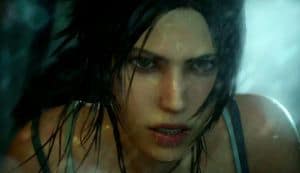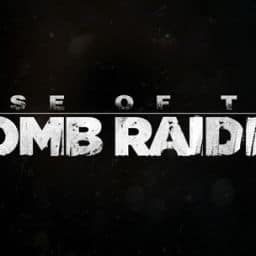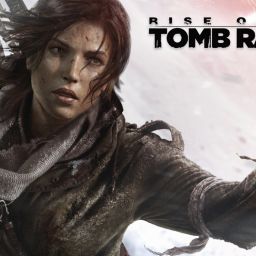by Kristin Bezio
The Tomb Raider franchise is old, in videogame years, dating back to 1996, and has appeared on an impressive array of consoles and platforms. It has something of a reputation – a sardonic one among the people I know – for its feature character, Lara Croft and her more-than-amply endowed upper half. She’s been held up by some feminists as the iconic representation of everything that’s wrong with the way women are portrayed in games, but she’s also been lauded as a stand-alone heroine who is actually featured on the box art of her games.
In 2013, Square Enix rebooted Tomb Raider, releasing a game whose final line – “A Survivor is Born” – encapsulates the focus of the game. As with the film Batman Begins, this new Tomb Raider restarts the franchise with an origin story meant to explain the main attributes of a character with which many fans will already be familiar.
I have to confess, I’ve never actually played a Tomb Raider game before this one. I have seen the Angelina Jolie movies. That said, I’m not sure how “true” to Tomb Raider canon this reboot actually is, or what elements of the original series were “lost” in this new rendition. But I also don’t really care, because Square Enix’s Tomb Raider is exactly what I always hoped the series would be.
First of all, Lara is a young but respected archaeologist, a woman with an advanced degree and a background of research. She’s an academic, a veritable Indiana Jones before the Lost Arc or the Temple of Doom (and really before the Crystal Skull, which I’m pretty sure should never have existed). Also, her chest is reasonably proportioned in this version, which was an enormous relief for my feminist sensibilities and, I’m sure, her back.
The point is, Lara – Dr. Croft – is smart, resourceful, and a better scholar than her colleagues on the ship. And at the start of the game, that’s her calling. She’s an academic interested in field research as well as books. Throughout the game, she finds relics which she describes, dating them, providing information on them, demonstrating that she’s not just a relic-hunter, but someone who has a keen interest in history and culture.
She is also about as far from a damsel in distress as you can get… aside from a really irritating penchant for breathing with this weird little gasping whine all the time. The sound design, for the most part, is really well-done, but there were times when I wanted to strangle Lara just to make her stop making THAT NOISE. But that’s really the only complaint I have about the whole game. No, really.
Because despite all the hullabaloo about Lara being assaulted in the game – and she is – she never once needs rescuing from anyone else. She defeats her attacker (and then every other person out to get her) all by herself, relying on instincts, resources, and skills that she develops throughout the game. Yes, she panics from time to time, but, really, in her situation, who wouldn’t? Weird creepy island, human sacrifices, weird crazy people hunting her down… that seems pretty panic-worthy. And yet, every time something happens to her, she pulls herself together, gets over it, and moves on. All by herself.
Furthermore, even the game’s obligatory father-figure, Roth, needs her help because his leg has been chewed by wolves. Yes, he provides knowledge and wisdom to her (and, we learn, was the one to teach her how to climb walls), and he does help her in a few sticky combat-situations, but she doesn’t rely on him to save her – Lara is never a damsel, although she is in a considerable amount of self-sufficient distress throughout the game.
SPOILERS BELOW:
One of the stronger narrative points in the game is the theme of sacrifice, and that’s where the game really demonstrates that Lara isn’t a damsel. Roth, Grimm, and Alex are the three male figures who give their lives to save Lara and the other remaining survivors. Roth takes an axe to the back to protect Lara in combat, Grimm drags his own captor over a ledge, and Alex – in the damsel position himself – triggers an explosion to take out an enemy-occupied ship. In fact, three if the survivors are women (Lara, Sam, Reyez), and only one of them is even remotely damseled (Sam, who really is the proverbial damsel – and princess – in distress, but Lara’s the one who keeps saving her). Reyez and Lara are nobody’s damsel, and they make sure everybody knows it.
The narrative itself is fairly rich, although I was a little disappointed that the game chose to go with a supernatural rather than scientifically plausible theme. I was happy with the weird creepiness of the island, but was hoping that the storms and other oddities would be the result of some strange experiment-gone-wrong rather than ancient-evil-undead, but at least the “rules” of the supernatural part were consistent.
END SPOILERS
In terms of gameplay, Tomb Raider was enjoyable – new skills were introduced quickly, but not too quickly. As a player, you had the opportunity to get used to the bow before you found a gun, get used to that before you got fire arrows, and so on. You also began to notice elements of gameplay that indicated future mechanics you didn’t have yet… which also told you that you would return to an area, so you didn’t become overly frustrated by being unable to reach a prize somewhere in the level.
And the maps were fantastic. They told you what you were missing, the percentage of the map you’d completed, and even allowed you to go back to prior areas (through fasttravel camps). From the perspective of a completionist, it was really, really nice to be able to know those things, rather than wandering around hoping you’d found all the relics or the diary entries, only to discover hours later than you missed something and now have to replay those hours.
Overall, even though Tomb Raider didn’t get a high metacritic score, it’s one of the more enjoyable games I’ve played this year, and is hands-down a better depiction of female agency than Fable III (also, basic language skills! Bonus!). The gameplay feels natural, it makes the player feel clever, and it’s a pretty game. Every time you pause it, you look at the still image and think “That is so pretty.” It’s a well-made, decently-written, well-executed game that deserves a play-through. And yes, the husband agrees.







One of the things I liked about the game was that despite being competent, Laura isn’t presented as being a super person. The game is about a journey of growth and discovery for her. It’s a kind of (quite brutal) growing up story as she faces challenges and learns that she can handle them with her new skills. It includes a lot of inner struggling and character building between her and the secondary characters as well.
She was the three dimensional, well developed character with agency that I wanted her to be.
I wholeheartedly recommend Tomb Raider 1 and 2 on the Playstation. The graphics are a bit pixelly and dated, but the gameplay is astounding, especially if you consider the clunky controls of the contemporary 3D games. I think it was in TR2 when Lara got the ability to do running side-somersaults whilst firing akimbo UZIs. And you could draw your weapons mid-jump, which was also pretty ground-breaking. They didn’t use a “pre-recorded” jump animation that had to be completed before you could input the next command, as was common at the time (especially in fighting games).
On a technical note, TR1 loads an entire 3D level about as quickly as Resident Evil 1 loads a single static 2D room. The use of lighting and perspective is also excellent, especially in TR2. It was the first game ever to give me a physical sense of vertigo.
I’ll leave the feminist analysis to you, as I am ill equipped to do that. But AFAIK, Lara was the first female protagonist of an action-oriented game. At the time, it was pretty amazing. I read loads of PS gaming magazines back then, and pretty much everyone agreed that TR could only have been released on PS, as Sony had a sort of open-door policy regarding games. Nintendo, on the other hand, has (had?) total control over every game released for their consoles, which meant fewer games but higher average quality. PS was pretty punk in that regard. They even released DIY kits for homebrew games, and regularly published the resulting minigames in the CD that came with the official PS magazine. This meant that comparatively small publishers could release games they believed in, without the risk of having them stopped by some corporate gatekeeper. Such a gatekeeper could easily have said “nah, we can’t have a female protagonist, change her to a male and we have a deal”. As it was pretty unthinkable at the time that the overwhelmingly male audience would accept playing as a *shudder* GIRL.
I wish I could! I don’t have access to a Playstation… at least not yet. Is TR available on the PS3 as a backwards-compatible game? Or on PC? I have a nefarious (well, maybe not really nefarious) plot to do a critical comparison of the new to the old, but I’d have to PLAY the old first…
Yup, it is available on Steam! You can buy all of the games individually or bundled in a package deal.
I can’t imagine playing with mouse-and-keyboard though. Or on a modern screen. The old CRT TVs sort of smoothed out the pixels, playing on a high res screen would probably feel like running a cheese grater over your eyeballs. Nevertheless, I hope your nefarious plan comes to fruition!
Other early PS1 games that might be of interest from a girls-in-games standpoint are the aforementioned Resident Evil, and Silent Hill. In RE, you can choose to play as Chris or Jill, and they have slightly different abilities. Jill has two more inventory slots (women and their handbags! amirite fellas?), and Chris has a few more hit points. Jill also has the lockpick, which is established in the now classic cutscene: (“Jill, here’s a lockpick. It might be handy if you, the master of unlocking, take it with you.”). The script and voice acting is slightly less-than-stellar.
Silent Hill didn’t introduce a female protagonist (there are entirely different protagonists in each game) until the third installment, but she is pretty capable. SH1 has a male protagonist searching for his lost daughter, and SH2 has another male searching for his dead (!?) wife. The SH games are a challenge to analyze, as the monsters and story progression are tied to the psyche and backstory of the protagonist.